Florida is home to many types of birds, and white birds are some of the most eye-catching and beautiful. Their bright white feathers stand out against Florida’s green trees and blue waters. From the large, elegant Great Egret to the smaller, graceful Snowy Egret, these birds thrive in the state’s perfect habitats. Whether you’re visiting the beach, wetlands, or parks, you’re likely to see one of these amazing white birds. This guide will help you recognize and enjoy some of the most common white birds in Florida.
10 white birds in Florida
| No. | Bird Name | Description |
|---|---|---|
| 1 | Great Egret | Large white bird with a long neck and legs; known for its graceful flight. |
| 2 | Snowy Egret | Smaller white egret with black legs and yellow feet; has a thin, black bill. |
| 3 | American White Ibis | White bird with a curved orange bill and legs; often seen in groups. |
| 4 | White Pelican | Large white bird with a yellow-orange bill and pouch; often seen gliding over water. |
| 5 | Cattle Egret | Smaller white bird often seen near livestock; has a short neck and yellow bill. |
| 6 | Wood Stork | Large white bird with a bald, dark head and long legs; often found in wetlands. |
| 7 | Great White Heron | A rare, all-white version of the Great Blue Heron; tall and elegant. |
| 8 | White-winged Dove | Medium-sized white bird with a black spot on its cheek; often seen in urban areas. |
| 9 | Whooping Crane | Tall, white bird with black wingtips and a red crown; endangered species. |
| 10 | White-tailed Kite | Small white bird with long wings and tail; often hovers while hunting. |
1. Great Egret
The Great Egret is a stunningly elegant white bird, renowned for its striking appearance and widespread presence throughout Florida. With its gleaming white feathers, long slender neck, and pointed yellow beak, the Great Egret is a standout species in the avian world. Native to Florida, this graceful wader is often spotted in the state’s marshes and wetlands, particularly in the lush environments of Southeast Florida.

A Symbol of Elegance in Florida’s Wetlands
The Great Egret’s graceful presence has made it a favorite among birdwatchers and nature lovers alike. Whether seen perched majestically on a branch or gliding through shallow waters in search of prey, this bird captivates onlookers with its serene beauty. Its long legs and neck are perfectly adapted for wading in shallow waters, allowing it to expertly hunt for fish, amphibians, and insects.
A Master of the Hunt
As a skilled predator, the Great Egret uses its sharp beak to swiftly catch its prey, striking with precision. Its hunting abilities are perfectly suited to Florida’s vast wetlands, where it thrives on a diet of small aquatic creatures. Watching a Great Egret hunt is a mesmerizing experience, as the bird’s patience and quick reflexes showcase its mastery of survival in the wild.
Nesting and Breeding Habits
During breeding season, Great Egrets gather in large colonies known as rookeries, where they build impressive nests made from sticks and twigs in trees near water bodies. These rookeries are typically located in secluded areas, providing a safe and quiet environment for raising their young. The sight of a rookery, with dozens of Egrets tending to their nests, is a remarkable example of nature’s harmony and cooperation.
An Icon of Florida’s Natural Beauty
The Great Egret is more than just a beautiful bird; it has become an emblem of Florida’s rich wildlife and ecological diversity. Its striking presence in the state’s wetlands not only enhances the natural scenery but also plays an important role in the local ecosystem. The Great Egret’s ability to thrive in Florida’s marshes and coastal areas underscores the health and vitality of these environments.
A Magnet for Nature Lovers
For both locals and visitors, encountering a Great Egret in its natural habitat is an unforgettable experience. Its elegance and calm demeanor embody the peaceful, untouched beauty of Florida’s wetlands, making it a key attraction for eco-tourism and wildlife enthusiasts.
In summary, the Great Egret’s majestic beauty and ecological importance make it one of the most beloved and recognizable birds in Florida. Its presence in the state’s wetlands is a testament to the region’s natural charm and allure, attracting countless visitors who are eager to witness this magnificent bird in its element.
| Feature | Details |
|---|---|
| Lifespan | Up to 15 years in the wild |
| Diet | Fish, frogs, insects, small mammals |
| Habitat | Wetlands, marshes, lakes, coastal areas |
| Breeding | Nests in large colonies in trees or shrubs |
| Migration | Some migrate south for winter, while many stay in Florida throughout the year |
2. Snowy Egret
The Snowy Egret is a small, beautiful bird that is easy to spot in Florida’s wetlands, marshes, and coastal areas. Known for its pure white feathers, black beak, and bright yellow feet, this elegant bird is a favorite among birdwatchers. Despite its small size, the Snowy Egret stands out with its graceful movements and unique features.
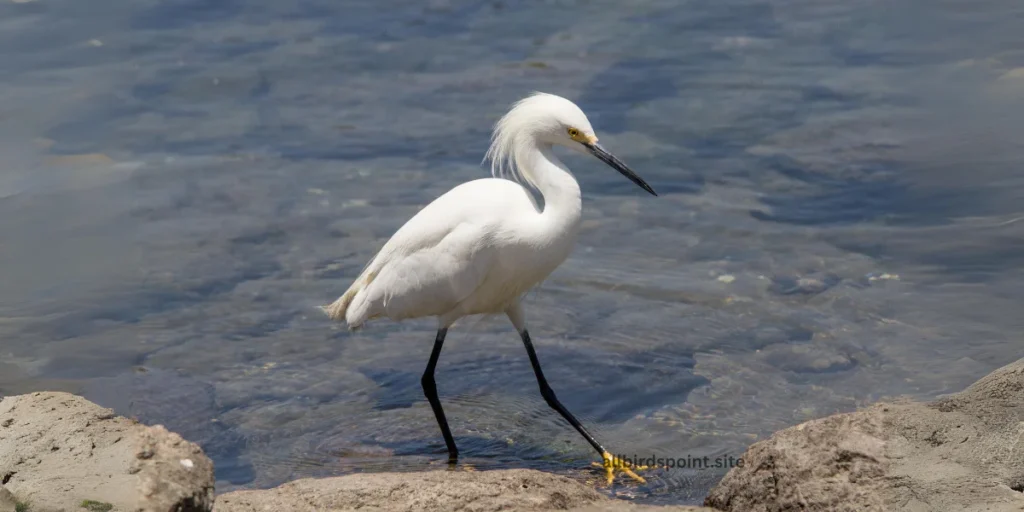
A Bird of Beauty and Grace
The Snowy Egret may be smaller than other egrets, but its striking appearance catches the eye. Its bright yellow feet help it stand out as it moves through the water. The bird uses these colorful feet to stir up small fish, insects, and crustaceans while hunting. Watching a Snowy Egret hunt is fascinating as it moves quickly and gracefully across the water.
Nesting and Breeding
During the breeding season, Snowy Egrets form large groups, called rookeries, where they build nests from sticks in trees or shrubs near water. These safe areas help protect their young from predators. During this time, the Snowy Egret grows beautiful long feathers on its head, making it even more stunning to see.
A Success Story in Conservation
Snowy Egrets were once hunted for their beautiful feathers, which were used in fashion. This led to a big drop in their population. Thanks to wildlife protection laws, the Snowy Egret has made a great recovery and is now a symbol of successful conservation efforts.
Important to Florida’s Ecosystem
The Snowy Egret plays an important role in Florida’s wetlands. By feeding on small fish and insects, it helps keep the balance of these ecosystems. A healthy population of Snowy Egrets is a sign of a healthy wetland, making this bird an important part of Florida’s natural beauty.
Experience the Snowy Egret
If you enjoy nature, seeing a Snowy Egret in its natural habitat is a must. Whether wading through the water or perched on a branch, this bird is a beautiful symbol of Florida’s rich wildlife. Its graceful movements and striking white feathers make it a true standout in the wild.
| Feature | Details |
|---|---|
| Lifespan | Up to 17 years in the wild |
| Diet | Fish, shrimp, insects, small amphibians |
| Habitat | Wetlands, beaches, lakes, coastal areas |
| Breeding | Nests in colonies, building nests in trees or shrubs |
| Migration | Migrates south in winter, though some stay in Florida year-round |
3. American White Ibis
The American White Ibis is a common and easily recognizable bird in Florida. Known for its bright white feathers, long pink legs, and a distinctive curved pink beak, the White Ibis is often seen in wetlands, parks, and even neighborhoods. Its gentle appearance and social behavior make it a favorite bird for both locals and visitors to spot.

A Bird of Many Habitats
The American White Ibis can be found in many places across Florida, including swamps, marshes, and along the coast. You may even see them in urban areas, like parks and backyards, where they search for food. These birds prefer shallow waters, where they can use their long beaks to dig into the mud for food like small fish, insects, and crabs.
Social and Friendly
White Ibises are very social birds. They are often seen in large groups, walking together through wetlands or flying in a V-shaped formation across the sky. Their social behavior makes them fun to watch as they move together in flocks, either foraging for food or finding a place to rest.
Nesting and Raising Young
During the breeding season, American White Ibises form large colonies to nest together. They build their nests in trees or shrubs near water, using sticks and grass. Both parents take turns feeding their chicks, which helps the young birds grow strong and ready to join the flock.
Easy to Spot
With their bright white feathers and pink beaks, American White Ibises are easy to spot, even from a distance. Their friendly nature and frequent appearance in parks and urban areas make them a bird you’re likely to see up close if you live in or visit Florida.
A Key Part of Florida’s Wildlife
The American White Ibis plays an important role in Florida’s wetland ecosystems. By eating insects and small animals, they help keep the environment balanced. Their presence is a sign of healthy wetlands, which are important for Florida’s wildlife.
See the American White Ibis for Yourself
Whether you’re a birdwatcher or just love seeing wildlife, the American White Ibis is a bird you’re sure to enjoy. With its graceful movements and social nature, it’s a wonderful part of Florida’s natural beauty.
| Feature | Details |
|---|---|
| Lifespan | Up to 20 years in the wild |
| Diet | Insects, crustaceans, small fish, amphibians |
| Habitat | Wetlands, marshes, grasslands, urban parks |
| Breeding | Nests in large colonies, often with other wading birds, building nests in trees or bushes |
| Migration | Partial migrant; some migrate south, while others remain in Florida year-round |
4. White Pelican
The White Pelican is one of the most impressive and largest birds you can find in Florida. Known for its bright white feathers, long yellow bill, and wide wingspan, this bird is easy to spot as it glides gracefully through the sky or floats on the water. The White Pelican is a popular sight in Florida’s lakes, wetlands, and coastal areas, and it is admired for its size and beauty.
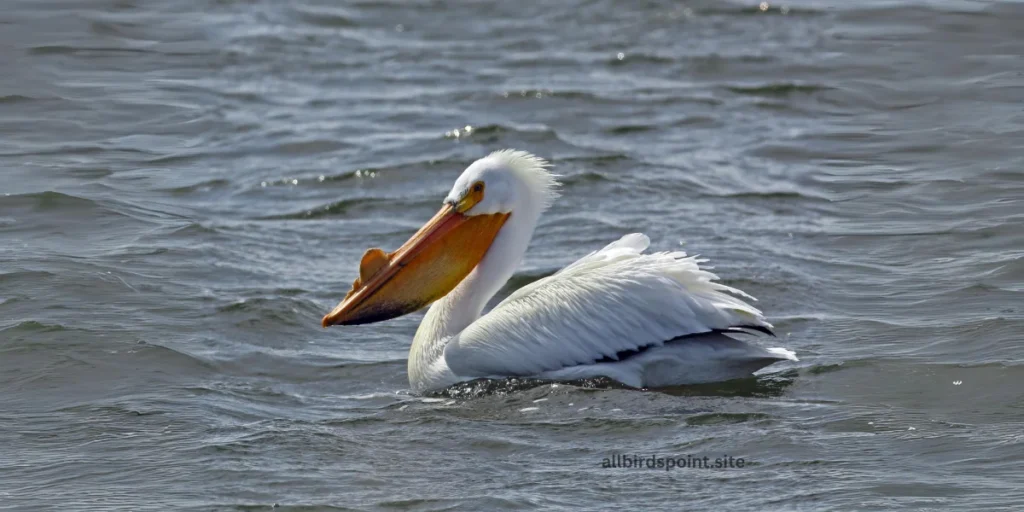
A Bird with Impressive Size
White Pelicans are among the largest birds in North America. They can have a wingspan of up to nine feet, which makes them truly impressive when they fly. Despite their large size, White Pelicans are known for their graceful flight, often seen gliding in groups high above the water.
Feeding Habits
Unlike other pelicans, White Pelicans don’t dive for their food. Instead, they work together in groups to herd fish into shallow water. Using their long yellow bills, they scoop up fish from the surface of the water. This teamwork makes them excellent hunters and fascinating to watch as they feed.
Migration and Nesting
White Pelicans are migratory birds. They spend their winters in Florida and other southern states, but during the summer, they migrate to northern states and Canada to breed. They usually nest in large colonies on islands or secluded areas near freshwater lakes. Their nests are made on the ground from grass, sticks, and dirt.
A Gentle Giant
Even though White Pelicans are large birds, they are known for their gentle nature. They are often seen floating peacefully on lakes and wetlands or resting together on sandbanks. Their calm and social behavior makes them a joy to observe in the wild.
A Key Part of Florida’s Ecosystem
White Pelicans play an important role in Florida’s wetland ecosystems. By feeding on fish, they help keep fish populations in balance, which is crucial for the health of the ecosystem. Their presence also attracts birdwatchers and nature lovers, adding to Florida’s appeal as a wildlife destination.
Experience the White Pelican in Florida
If you enjoy birdwatching, seeing a White Pelican in flight or floating on the water is an unforgettable experience. Their massive size, peaceful nature, and unique way of hunting make them one of Florida’s most interesting birds to watch.
| Feature | Details |
|---|---|
| Lifespan | Up to 30 years in the wild |
| Diet | Mainly fish, but also amphibians |
| Habitat | Lakes, rivers, marshes, and coastal areas |
| Breeding | Nests on the ground in colonies, often on islands or isolated areas |
| Migration | Migrates to southern areas in winter |
5. Cattle Egret
The Cattle Egret is a small, sturdy white bird with a distinctive orange bill and legs that is often seen in fields and near livestock in Florida. Unlike other egrets that prefer wetlands, the Cattle Egret has adapted to life in grassy areas and open fields, making it a familiar sight in both rural and urban environments. Its unique habit of following cattle and other large animals has earned it its name.

A Unique Lifestyle
Cattle Egrets are best known for their close relationship with grazing animals like cattle, horses, and even deer. They often follow these animals to catch insects that are stirred up from the grass. This behavior makes the Cattle Egret easy to spot in farmland or along roadsides. They feed mainly on insects, such as grasshoppers, crickets, and flies, but will also eat small frogs and lizards when they can.
Appearance and Behavior
During the breeding season, Cattle Egrets develop orange feathers on their heads, necks, and backs, making them even more eye-catching. They are social birds that are often seen in small groups, either walking through fields or perched on the backs of livestock. Their movements are quick and energetic as they chase after their insect prey.
Nesting Habits
Cattle Egrets nest in colonies, often alongside other types of herons and egrets. They prefer to nest in trees near water, even though they spend much of their time in fields. Their nests are built from sticks and are often reused year after year. Both parents help to raise the chicks, providing them with food until they are old enough to hunt on their own.
A Helpful Bird for Farmers
Because Cattle Egrets feed on insects that can be harmful to livestock and crops, they are considered beneficial to farmers. By eating pests, they help keep the environment in balance and reduce the need for chemical pesticides. This makes them an important part of Florida’s agricultural ecosystem.
Easily Spotted in Florida
The Cattle Egret is one of the easiest birds to spot in Florida, especially in rural areas or near farms. Their habit of following cattle and other animals makes them stand out, and their bright white feathers and orange bills are hard to miss.
Enjoy Watching Cattle Egrets
If you’re exploring Florida’s countryside or even driving through farmland, keep an eye out for the Cattle Egret. Watching them work alongside livestock and quickly darting after insects is both fun and fascinating, showing how animals can adapt to their environment in unique ways.
| Feature | Details |
|---|---|
| Lifespan | Up to 15 years in the wild |
| Diet | Insects, especially grasshoppers and flies, small amphibians and reptiles |
| Habitat | Grasslands, farmlands, pastures, wetlands |
| Breeding | Nests in colonies, often with other wading birds, building nests in trees or shrubs |
| Migration | Some migrate south in winter, while others stay in Florida year-round |
6. Wood Stork
The Wood Stork is a large, striking bird commonly found in Florida’s wetlands. Known for its unique appearance, with a bald, dark head and white feathers, the Wood Stork is one of the most distinctive birds in the state. It has long legs, a heavy curved bill, and a wingspan that can reach over five feet, making it an impressive sight whether it’s soaring in the sky or wading through shallow waters.

A Bird of Wetlands
The Wood Stork thrives in freshwater marshes, swamps, and mangroves, where it can be seen wading slowly through shallow waters in search of food. Unlike many other birds, it hunts by touch rather than sight. With its beak open, it sweeps it through the water, snapping it shut as soon as it feels a fish or small aquatic creature. This unique feeding style, combined with its large size, makes the Wood Stork a fascinating bird to observe.
Appearance and Behavior
Wood Storks are easily recognized by their white bodies contrasted with their black flight feathers and bare, scaly-looking heads. While not as brightly colored as some other Florida birds, their distinct appearance makes them stand out. When in flight, their large wingspan and slow, steady wingbeats create a majestic sight, often seen soaring in groups high above Florida’s wetlands.
Nesting and Breeding
Wood Storks are colonial nesters, meaning they nest in large groups, often in trees above water. These nesting colonies can be quite noisy, with birds building large nests from sticks and vegetation. During the breeding season, Wood Storks rely on abundant food sources to feed their young, so the health of Florida’s wetlands is crucial for their success. Both parents take turns feeding the chicks until they are ready to leave the nest.
A Success Story in Conservation
The Wood Stork is one of Florida’s success stories in conservation. In the past, its population declined due to habitat loss and changes in water levels that affected its feeding grounds. However, conservation efforts have helped the species make a comeback, and it is now listed as threatened rather than endangered. Protecting Florida’s wetlands is key to ensuring that Wood Storks continue to thrive.
A Key Part of Florida’s Ecosystem
Wood Storks play an important role in Florida’s wetland ecosystems. By feeding on fish and other small creatures, they help maintain the balance of these environments. Their presence also indicates healthy wetland conditions, which are vital for many other species of wildlife.
Spotting the Wood Stork in Florida
If you’re exploring Florida’s wetlands, keep an eye out for the Wood Stork. Whether soaring high above or wading through shallow waters, this large, graceful bird is an unforgettable part of Florida’s natural beauty. Watching a Wood Stork in its natural habitat offers a unique glimpse into the life of one of the state’s most interesting birds.
| Feature | Details |
|---|---|
| Lifespan | Up to 20 years in the wild |
| Diet | Primarily fish, but also insects, crustaceans, and small amphibians |
| Habitat | Wetlands, swamps, marshes, coastal areas |
| Breeding | Nests in large colonies, often in trees or on platforms over water |
| Migration | Some populations migrate, but many stay in Florida year-round |
7. Great White Heron
The Great White Heron is a large, elegant bird that is a rare and beautiful sight, primarily found in the Florida Keys and the southern tip of the state. Often confused with the Great Egret due to its striking white plumage, the Great White Heron is actually a color variation of the Great Blue Heron. Its impressive size, long legs, and large wingspan make it one of the most eye-catching birds in Florida’s coastal areas and wetlands.
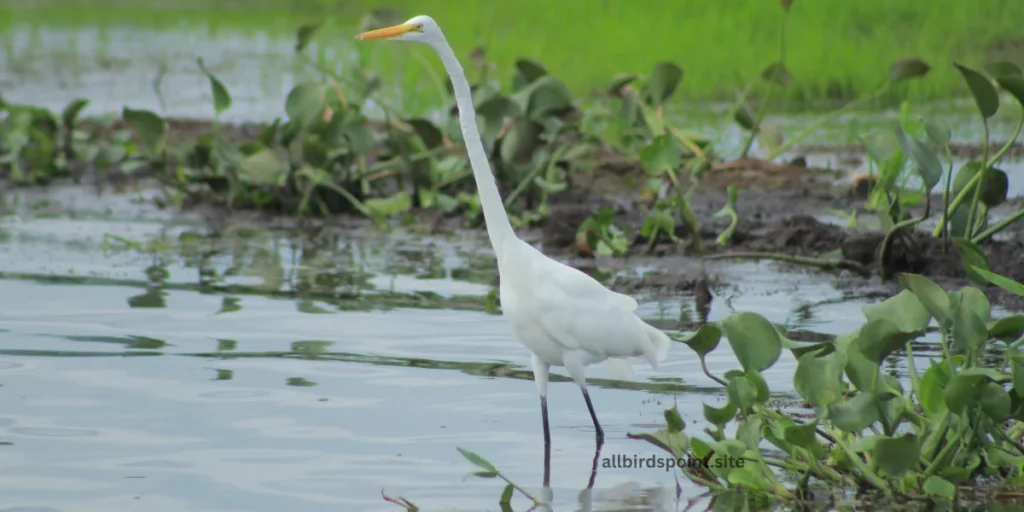
A Unique Coastal Bird
The Great White Heron is unique to Florida, particularly the Florida Keys, and is rarely found outside of this region. It prefers shallow coastal waters, tidal flats, and mangroves, where it can hunt for fish, crustaceans, and other small aquatic creatures. With its long legs and sharp beak, the Great White Heron wades through the water, standing still for long periods before quickly striking its prey.
Size and Appearance
This heron is a large bird, similar in size to the Great Blue Heron but covered in brilliant white feathers. Its long yellowish bill, pale legs, and graceful neck make it easy to distinguish from other white birds in the region. When in flight, the Great White Heron’s broad wings and slow, deliberate wingbeats create a majestic sight, making it one of the most impressive birds to watch in Florida’s coastal areas.
Feeding Habits
The Great White Heron is an expert hunter, feeding mostly on fish and other small aquatic animals. It uses a patient hunting technique, often standing motionless for long stretches before striking with lightning speed. This method helps it blend into its surroundings, making it harder for prey to detect its presence.
Nesting and Breeding
Great White Herons nest in trees and shrubs near water, often in remote coastal areas. Like other herons, they are colonial nesters, building large nests from sticks and vegetation. Both parents take part in caring for the chicks, feeding them until they are ready to leave the nest. The breeding season is an excellent time to spot these birds as they gather in nesting colonies.
Conservation and Protection
While the Great White Heron is not considered endangered, its limited range and reliance on coastal habitats make it vulnerable to habitat destruction and environmental changes. Protecting the coastal wetlands and mangroves where these birds thrive is crucial to their continued survival. The Great White Heron is a symbol of Florida’s rich coastal ecosystems, and efforts to preserve these habitats help protect this rare and beautiful bird.
See the Great White Heron in Florida
If you’re visiting southern Florida or the Florida Keys, the Great White Heron is a bird you won’t want to miss. Whether wading through shallow waters or taking flight across the horizon, its sheer size and grace make it a breathtaking sight. Birdwatchers and nature lovers alike will appreciate the opportunity to see this majestic bird in its natural habitat.
| Feature | Details |
|---|---|
| Lifespan | Up to 15 years in the wild |
| Diet | Fish and small amphibians |
| Habitat | Shallow coastal waters, mangroves in the Florida Keys and southern Everglades |
| Breeding | Nests in trees or mangroves, often in solitary locations |
| Migration | Mostly resident, though some may migrate to nearby areas during harsh conditions |
8. White-winged Dove
The White-winged Dove is a medium-sized bird that is easily recognized by its soft grayish-brown feathers and the distinctive white stripe on the edge of its wings. This beautiful bird is commonly found in Florida, especially in areas with open woodlands, parks, and suburban neighborhoods. The White-winged Dove is known for its soft cooing call, which adds a peaceful sound to the outdoor environment.
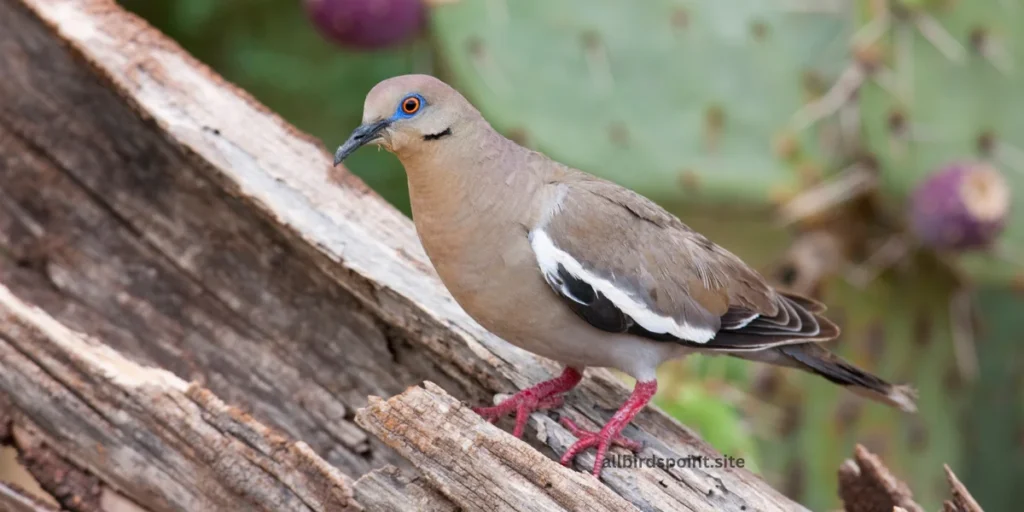
A Bird of Many Habitats
White-winged Doves can be found in a wide variety of habitats across Florida. They are often seen in areas with plenty of trees, such as forests, parks, and gardens. These birds have also adapted well to living near people, making them a common sight in backyards and urban areas. Their diet mainly consists of seeds, grains, and fruit, which they forage from the ground or from trees.
Appearance and Behavior
White-winged Doves are medium-sized birds, similar in appearance to Mourning Doves, but with a few key differences. They have a clear white stripe along the edge of their wings, which is easy to spot when they are in flight. Their eyes are bright red, and they have a blue ring of skin around them, giving them a striking look. Their flight is strong and direct, and they are often seen flying in small flocks.
Nesting and Raising Young
During the breeding season, White-winged Doves build small, simple nests in trees, bushes, or even on buildings. The nests are often made from twigs and grass. They lay one or two eggs, and both parents take turns caring for the chicks. The young doves grow quickly and are usually ready to leave the nest in about two weeks.
A Common but Beautiful Sight
Though White-winged Doves are common, they are still a joy to see and hear. Their soft cooing and graceful flight make them a peaceful presence in many outdoor spaces. They often gather in large numbers, especially around water sources or feeding areas, making them easy to spot in both rural and urban environments.
Important to Florida’s Ecosystem
White-winged Doves play an important role in Florida’s ecosystem by spreading the seeds of the plants they eat. This helps new plants grow and keeps the environment healthy. Their ability to adapt to different habitats has also made them a thriving species in Florida.
Spotting White-winged Doves in Florida
If you enjoy birdwatching or just love spending time outdoors, the White-winged Dove is a bird you’re likely to encounter. Whether you see them perched in trees or flying in groups across the sky, their distinctive white wing stripe and calming cooing sound make them a delightful part of Florida’s wildlife.
| Feature | Details |
|---|---|
| Lifespan | Up to 15 years in the wild |
| Diet | Seeds, fruits, and occasionally insects |
| Habitat | Urban areas, suburbs, and open woodlands |
| Breeding | Nests in trees or shrubs, often near human habitation |
| Migration | Generally a year-round resident in Florida, with some local movements |
9. Whooping Crane
The Whooping Crane is one of the rarest and most majestic birds in North America, and it is known for its bright white feathers, long black legs, and striking red crown. With a wingspan that can reach over seven feet, the Whooping Crane is one of the largest birds in the United States. Although it is a rare sight, efforts to protect and conserve the species have made it possible to see these incredible birds in parts of Florida.
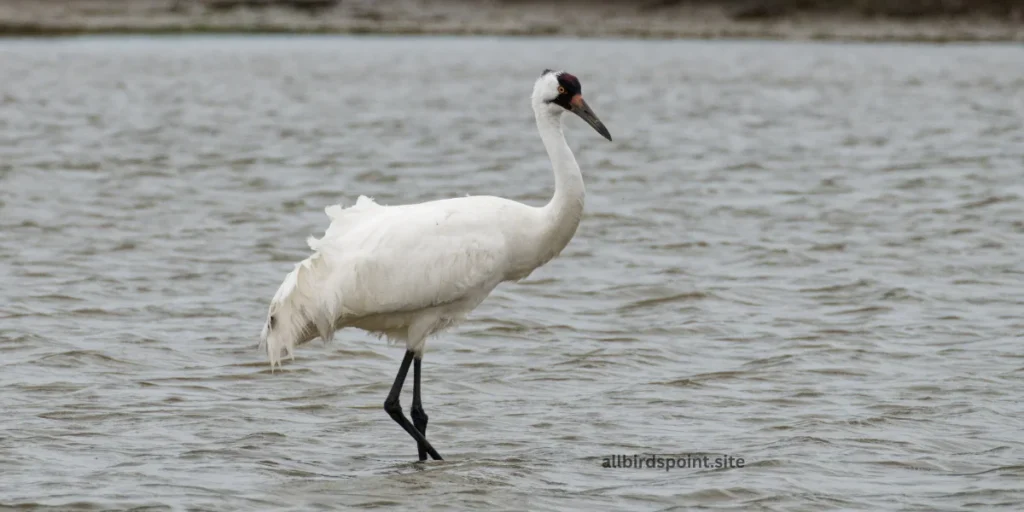
A Story of Conservation
The Whooping Crane has faced serious threats over the years, including habitat loss and hunting, which once brought their population to the brink of extinction. Thanks to dedicated conservation efforts, including breeding programs and habitat protection, the population of Whooping Cranes is slowly recovering. In Florida, some of these cranes have been introduced as part of reintroduction efforts, allowing birdwatchers to occasionally see them in certain areas.
Appearance and Behavior
Whooping Cranes are tall birds, standing nearly five feet tall, with white bodies, black wingtips, and a distinctive red patch on their heads. Their long necks and legs make them perfect for wading in shallow waters, where they hunt for food. These cranes feed on a variety of small animals, such as fish, frogs, insects, and even small mammals. They are also known to eat plants and grains, making them adaptable in different habitats.
Migration and Nesting
Whooping Cranes are migratory birds. During the winter months, some groups of Whooping Cranes migrate to Florida from their breeding grounds in the northern United States and Canada. They prefer to nest in wetlands, where they can build their large nests out of plants and vegetation. Whooping Cranes lay one to two eggs, and both parents take part in caring for the chicks.
Conservation Efforts in Florida
Florida is home to one of the reintroduced populations of Whooping Cranes. These birds are carefully monitored by conservationists to ensure their survival. Protecting wetlands and preventing habitat destruction are crucial to keeping the Whooping Crane population growing. Conservationists and wildlife organizations are working hard to restore and maintain the natural environments that these cranes depend on.
A Rare and Majestic Sight
Seeing a Whooping Crane in the wild is a rare and special experience. Their large size, graceful movements, and distinctive appearance make them one of the most fascinating birds to observe. If you’re lucky enough to spot one in Florida, you’ll witness the beauty of a species that has come back from the brink of extinction.
Protecting the Whooping Crane
The Whooping Crane is a symbol of successful conservation efforts, but it still faces challenges. Continued protection of their habitats and efforts to reduce human impacts on wetlands are essential to ensuring the species survives for future generations. The sight of a Whooping Crane in flight or wading through a marsh is a powerful reminder of the importance of preserving wildlife.
| Feature | Details |
|---|---|
| Lifespan | Up to 22 years in the wild |
| Diet | Fish, insects, plants, and small amphibians |
| Habitat | Marshes, wetlands, and estuaries |
| Breeding | Nests on the ground in wetlands, often in isolated areas |
| Migration | Migrates between breeding grounds in Canada and wintering areas in Texas and Florida |
10. White-tailed Kite
The White-tailed Kite is a small but striking bird of prey, known for its bright white head and body, gray wings, and long, narrow tail. Its red eyes and graceful flight make it easy to spot in open fields and grasslands across parts of Florida. This bird is a skilled hunter, often seen hovering in the air before diving down to catch its prey. Though not as common as some other birds of prey, the White-tailed Kite is a beautiful and fascinating species to observe.
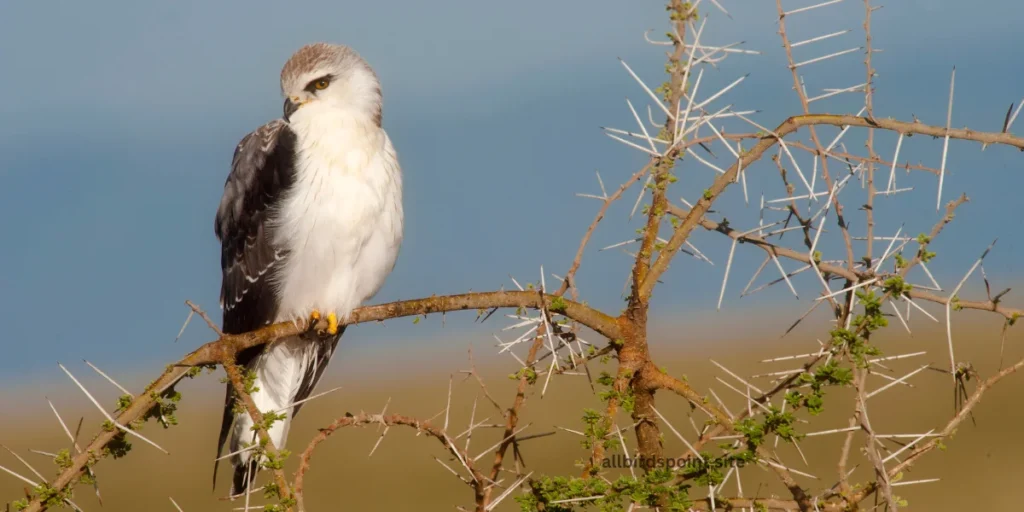
A Hunter of Open Spaces
The White-tailed Kite prefers open areas like grasslands, fields, and marshes where it can easily hunt for food. It feeds mainly on small mammals, especially rodents like mice and voles. This bird has a unique hunting style—it hovers in the air, flapping its wings rapidly to stay in one spot, scanning the ground below for movement. Once it spots its prey, it swoops down quickly to grab it with its sharp talons.
Appearance and Behavior
The White-tailed Kite is easy to recognize due to its bright white body, gray wings, and distinctive black patches on its shoulders. Its tail is long and white, which is particularly noticeable in flight. Its red eyes stand out against its white face, giving it a piercing look. This kite’s graceful flight and hovering ability make it a fascinating bird to watch as it hunts.
Nesting and Raising Young
White-tailed Kites usually build their nests in tall trees or shrubs, often near open fields where they can easily hunt. The nests are made from sticks and lined with softer materials like grass. They typically lay three to five eggs, and both parents take turns feeding and caring for the chicks. The young birds grow quickly and soon join their parents in hunting for food.
Conservation and Protection
While the White-tailed Kite population is stable in many areas, protecting their habitats is important to ensure they continue to thrive. They rely on open spaces with plenty of prey, so preserving grasslands and preventing habitat loss is essential for their survival. In Florida, you might find them in areas with vast fields and minimal human disturbance.
Spotting the White-tailed Kite
If you’re interested in birdwatching, the White-tailed Kite is a bird worth looking for. You’ll often see them hovering in one spot, scanning the ground for prey. Their bright white feathers and graceful movements make them stand out against the backdrop of open fields or clear skies. Watching a White-tailed Kite in action is a memorable experience for any bird enthusiast.
Important to the Ecosystem
The White-tailed Kite plays an important role in controlling rodent populations in the areas where it hunts. By keeping the numbers of small mammals in check, they help maintain the balance in the ecosystem. Their presence is a sign of healthy grassland and field environments.
| Feature | Details |
|---|---|
| Lifespan | Up to 10 years in the wild |
| Diet | Small mammals, insects, and reptiles |
| Habitat | Open grasslands, savannas, and agricultural areas |
| Breeding | Nests in trees or shrubs, often in open areas with good visibility |
| Migration | Generally a year-round resident in Florida, with some local movements |
Types of Birds in Florida
Colorful Birds
Florida has many beautiful, colorful birds. For example, the Northern Cardinal is known for its bright red feathers and distinctive black mask. The Roseate Spoonbill has stunning pink feathers and a unique spoon-shaped bill. These birds add vibrant colors to Florida’s landscapes.
Shore Birds
On Florida’s beaches and shores, you can find birds like the Royal Tern and the Black Skimmer. The Royal Tern has striking black markings on its head and a long, slender beak. The Black Skimmer is known for its unique bill, which has a lower mandible longer than the upper mandible, helping it skim the water for fish.
Wetland Birds
Florida’s wetlands are home to many wading birds. The Great Egret is a tall bird with all-white feathers and a graceful neck. The Wood Stork is another wetland dweller with a bald head and long legs, perfect for wading through shallow waters. These birds use their long bills to catch fish and insects.
Birds of Prey
Birds of prey, or raptors, can also be found in Florida. The Bald Eagle, with its white head and yellow beak, is the national bird of the United States and is often seen soaring high in the sky. The Red-shouldered Hawk is another raptor, known for its distinctive red shoulders and loud call.
Urban Birds
In cities and towns, you can spot birds like the Mourning Dove and the House Sparrow. The Mourning Dove is a common sight, with its soft gray feathers and gentle cooing. The House Sparrow is small and adaptable, often found around human activity.
Birdwatching Tips
If you want to see these birds, here are some tips:
- Visit Different Habitats: Go to beaches, wetlands, parks, and urban areas to see a variety of birds.
- Use Binoculars: A good pair of binoculars will help you get a closer look at the birds without disturbing them.
- Bring a Field Guide: A bird guidebook or app can help you identify different species and learn more about them.
- Be Quiet and Patient: Birds can be shy, so it’s important to move slowly and quietly to avoid scaring them away.
Florida’s diverse habitats provide homes for many bird species. Whether you’re a seasoned birdwatcher or just starting out, there’s always something new to discover in the world of Florida’s birds.
FAQs
1. What are some common white birds in Florida?
Common white birds in Florida include the Great Egret, Snowy Egret, and American White Ibis.
2. Where can I see white birds in Florida?
You can find white birds in various habitats, including wetlands, beaches, marshes, and coastal areas.
3. What do white birds in Florida eat?
Their diets typically include fish, insects, small amphibians, and crustaceans.
4. Are white birds in Florida migratory?
Some white birds, like the Great Egret, migrate, while others, like the American White Ibis, may stay in Florida year-round.
5. How can I identify white birds in Florida?
Look for distinctive features such as bill shape, leg color, and size. For example, the Snowy Egret has black legs and yellow feet, while the Great Egret is all white with a long neck and legs.

2 thoughts on “10 White Birds in Florida: Guide with Facts, List and Pictures”